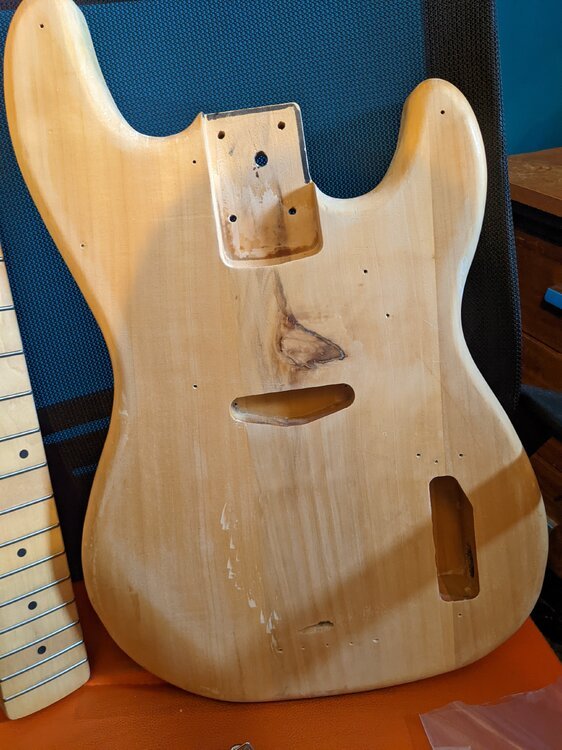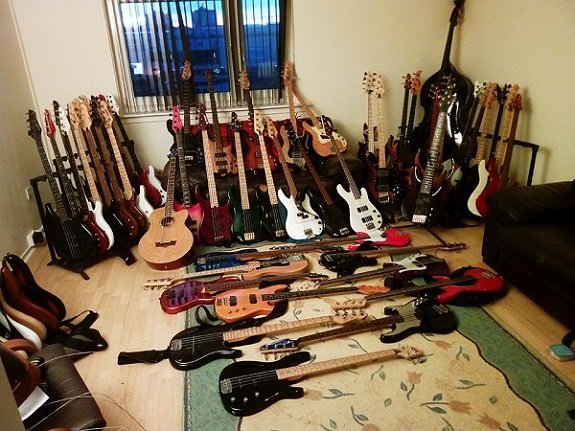
kodiakblair
Membre-
Posts
61 -
Joined
-
Last visited
Content Type
Profiles
Forums
Events
Everything posted by kodiakblair
-
Harley Benton Pb-50 Sb Vintage Series
kodiakblair replied to hutch30's topic in Revues des basses des membres
I spoke with an English player, he toured with a Rock n Roll revival show for 2 years using the PB-50; 300+ shows without any problems 🙂 With it's status as a veteran of the road secure the PB-50 accepted retirement gracefully, still makes an appearance once a month for Blues gigs. Wonderful bass the PB-50 😎 -
1er prix de marque prestige vs haut de gamme d'une marque grand public
kodiakblair replied to Gorzogue's topic in Basse
Neither, I prefer to play the one fit for purpose. My taste runs to single coil P-basses. I have a Fender Japan Paisley P-bass from the early 90's, it's a nice bass with a lovely finish. Manufacture is precise and the tone pleasing. I also have a Harley Benton PB-50 from 2013, price on purchase was a mere £78 By rights the Benton should be rubbish compared to the Fender, this is not the case. The Benton manufacture is good. Pots/tuning pegs/bridge etc, all the areas costs are saved, remain stock. The Wilkinson single coil is superb, like a Seymour SCPB-1 only with higher output. It is the neck where the PB-50 really shines, thinner than the Fender and with a matt instead of gloss finish I find it easier to play. The PB-50 rendered the Fender a vanity Of course here I am comparing the most basic of bass design, to succeed all a single coil P-bass must do is play comfortably -
No idea of trade in but I saw one of mine listed for sale on the UK Basschat forum recently. I sold it for £450 in 2018, buyer got £750 for it last month. There has been another T-40 on the Basschat forum since last August, also priced at £750 yet this one has had little interest. This £750 figure appears in line with a bassic.de discussion I was involved in, that was back in December 2021 with German players saying they thought 600€ - 650€ to be a realistic price.
-
Harley Benton Pb-50 Sb Vintage Series
kodiakblair replied to hutch30's topic in Revues des basses des membres
Don't concern yourself with the machine head spacing, those are fixed points. You will not get the generic PB-50 tuning pegs to match the spacing of the Schallers fitted to the T-40. Just follow the method I described in the Basschat thread. Work from the back of the headstock and keep the two straight edges matching. -
Harley Benton Pb-50 Sb Vintage Series
kodiakblair replied to hutch30's topic in Revues des basses des membres
@Father Ted No trouble at all, I have a couple of T-40's in parts Reached my attachment allowance but you can access the scan with this link . https://www.amazon.co.uk/photos/share/5TY0HzweoyuqxumAEzeqkM4nqmURgdP1DHK6IpXOO3q Print out at 100%, with careful positioning you will achieve the re shape. As for how hard/tender the body wood is, PB-50s are reasonably resilient. I'm not particularly careful with my basses yet my oldest PB-50, 9 years , is in great shape. Enjoy your project and I look forward to seeing the end result. -
I just clicked your 'reveal hidden contents' , those are not failings
-
Harley Benton Pb-50 Sb Vintage Series
kodiakblair replied to hutch30's topic in Revues des basses des membres
I own several Peaveys, would you like a trace/scan of the T-40 headstock ? Hideous is always an option I was given this stripped PB-50 body last year -
Harley Benton Pb-50 Sb Vintage Series
kodiakblair replied to hutch30's topic in Revues des basses des membres
Well if you need any further explanation just ask , I posted that Basschat thread -
Harley Benton Pb-50 Sb Vintage Series
kodiakblair replied to hutch30's topic in Revues des basses des membres
I feel the same way about mine, soon to celebrate our 9th anniversary -
There was two versions of Indonesian Cirrus, both were built in the Samick factory. Peavey released the Cirrus BXP in 2007. Those started out as 35" scale length but the four strings later changed to 34" scale length. The BXP pickups are the exact same as those used for US Cirrus models, three band EQ boosts/cuts the same frequencies to the same level as US models. Instead of an ABM bridge these had single saddle bridges. Discontinued in 2015. I see these sell for £3-400 here in the UK. 2017 saw the Cirrus relaunched. They followed US spec to the letter. An extra feature was the inclusion of the 'Power Plate', this was Peavey's version of the 'Fathead'. A pointless addition in my opinion as 2+2/ 3+2 reduced headstocks rarely suffer from dead spots. All had rosewood fretboards Though fine basses, they were a marketing disaster. Peavey released them three weeks after the CITES ruling on rosewood and bubinga changed. The extra paperwork headache concerning rosewood boards meant no distributors would take them, only country Peavey could sell them in was the USA. Price was another factor which doomed the 2017 Cirrus. They carried a price tag of $1200 for four strings, $1500 for five strings. In 2017 you could buy a used US Cirrus for $600.
-
In reality , Much closer than folk care to admit with the "darkwood" BXP too close for comfort. A Cirrus owning friend was visiting from England , on the drive here she acquired a "darkwood" Cirrus BXP 5 string for £199 . Left to right Cirrus BXP, Bubinga bolt on , Walnut , Mahogany bolt on, Darkwood BXP. https://imgur.com/zndb4in My Cirrus credentials were roughly the same. Teal, Tiger eye custom , Walnut and a BXP model ; also this Mahogany bolt on. https://imgur.com/Wu6dbJg[img]https://i.imgur.com/6yR5iyEm.jpg[/img] Safe to say we were well acquainted with US Cirrus basses. Her recently purchased BXP darkwood was put to the test with both of us concluding it looked like a US Cirrus/sounded like a US Cirrus/played like a US Cirrus and in the hand felt like a US Cirrus. BXP models use the same VFL pickups as the US models , their preamps +/- at the same frequencies as the US models by the same level of dB. Their downfall in my opinion is the gloss finish on the neck. No gloss finish on the darkwood we were so impressed with
-
Thanks. I am no expert, I just own a lot of Peaveys I have been very lucky in owning at least one of each model they released.
-
Hi Karmacoma. Your correct about the US Cirrus , they were discontinued in 2010. Actually all US production ended in 2010. Asian Cirrus production ran from 2007 until 2015 , this was at the Samick Indonesian factory. Production started back up in 2017 , again with Samick Indonesia. This later version was almost an exact replica of the US models. Peavey decision to have a rosewood fretboard had a serious effect on sales. The bass debuted 3 weeks after the CITES regulations of rosewood started. No international distributors ordered the new Cirrus leaving Peavey with only the US market to try and sell them. Launch prices were $1200 for 4 strings , $1500 for 5 strings ; there was no 6 string model. At that time US Cirrus basses were selling for $600 to $700 on the used market ; meaning almost no-one bought the new Indonesian version. The new model was dropped in 2018. Microphones are Peavey's VFL ( vertical flux loaded). These were designed by Peavey's bass guru Mike Powers ,; production of the VFLs was by G&B , a Korean company. Those VFLs appeared in many Peavey models both US and Asian. Mike was impressed by the G&L MFD microphone so set out to copy them. Originally conceived as a passive unit it was too close to the G&L product, a letter from G&L's legal team saw the microphone change to active Preamp is a 3 band EQ , designed in the US but produced in Korea. For a US bass very little was US made. Along with the Korean microphones/preamp ,the tuning keys / knobs/ strap buttons and covers were also Korean. The bridge is from Germany , Tusq nut is Canadian. Zephyr humbuckers are nice. Quite hot with ceramic magnets , DCR around 14.38 K ohm . Typical 4 wire humbuckers , you can add a switch for series/passive or single coil.
-
Firstly. My apologises for writing in English . I'm Scottish , my English is passable but my grasp of French is sadly lacking. The Cirrus I'm sure you know. Introduced in 1997 as a thru neck active bass. Screwed neck version was offered in 2005 with Asian models appearing in 2007. Thru neck 4/5/6 string versions were 35" scale ; screwed neck 4 string was 34" These were Peavey's premier basses The Zephyr/C-series launched in 1999. Only available for the European market. 4 string models were screwed or thru , 5 strings only thru. A passive bass with 2 soapbar humbuckers wired 2 vol/2 tone. Manufactured in Vietnam by the Inyen Vina company. All were 34" scale length. Released mainly to gauge demand for a lower cost passive Cirrus style bass. Build quality was high , sales figures were good yet discontinued by 2001. The Grind first appeared in 2001 as a screw neck USA built bass. 4 strings were 34" scale length, 5 strings 35" scale. 4 string was a PJ , 5 string a JJ ; both were active/passive. In 2002 they were joined by Asian built BXP versions. USA models discontinued in 2003 . The BXP was replaced in 2004 as a passive neck thru 35" scale , my understanding is the sales of the Zephyr/C-series greatly influenced this change. The Grind BXP NTB came as 4,5 and 6 string models , again built by Inyen Vina in Vietnam. Production briefly moved to China , cost proved too expensive in China so production moved to Samick's factory in Indonesia where it remained until 2019 when the model was discontinued. With this brief history outline over I could provide more details regarding the electronic, microphones etc. That is, of course , if you are still interested. A small photo of Scotland's home for Wayward Peaveys.
-
Why do you think that ? Is farming easier than working in a guitar factory ? http://www.xinhuanet.com/english/2017-12/22/c_136846101.htm My apologises for the article being in English , search for the French edition came up short .
-
Cost , convenience and brand image. The shape/size of VFL shells were unique to Peavey , this meant G&B in Korea needed molds made. Plastic injection molds are hugely expensive so to gain maximum value for money those molds were used for nearly every pickup . With all the shells coming from one source , the supply chain ran smoother. That also allowed Peavey more bargaining power over costs , the shell pressing factory would find no secondary buyer for these should Peavey re-negotiate the price. Lastly , having all basses use the same shells marked them out as Peavey basses .
-
No, those are just VFL shells. Beneath the shells lurks a passive ceramic single coil.
-
@cricriii With regard to the PJ 5 HTR, I am sure you found an improvement after the pickup replacement. It has been 7 years since I owned the PJ 4 -HTR. I recall the bass being well constructed but my memory of astounding tones is sadly lacking. I should have placed my previous post firmly in a single coil P-bass context. Some basses do benefit from a pickup change. Replacing Seymour Duncan Quarter Pound'er PJ set with Entwistle Neodymium was a definite improvement.
-
Not strictly true. "Better" is merely personal taste, possibly tempered by prejudice A few years back I installed and recorded short clips of different single coils in a PB-50. Some of the pickups used were the original Wilkinson, later Roswell, Bloodstone 51, Seymour Duncan SCPB-1/SCPB-2, Martin Herrick custom builds (Alnico & Neodymium), a Peavey Super Ferrite, custom overwound single (Dusty Hill 29.9k ohm) and finally an extremely cheap Alnico 5 bought from China. With different magnets and wire counts the only constant was pickup position and pickup height. It was a blind test. No brands were named, I just asked listeners to state which clip they thought was the cheap Chinese pickup. 80% answered wrongly The actual breakdown was each clip had the same number of people saying it was recorded using the Chinese pickup. Magnets, wire counts and brand names contribute very little when compared to the effect the pickup position has.
-
Harley Benton Pb-50 Sb Vintage Series
kodiakblair replied to hutch30's topic in Revues des basses des membres
Now available I donated a PB-50 PG for use as a template by maker in Glasgow. He offers many colour options in 1,3 and 4 ply material. His is an ebay only business. https://www.ebay.co.uk/usr/earlpilanz Perfect fit around the neck and control plate. -
Fabrication PB 51 façon cabronita
kodiakblair replied to frankybabass's topic in Lutherie et réglage
Cabronita build from last year. Mahogany body. Finished product. -
Yes. I tried to buy one in the Summer but the seller changed their mind. I decided to build one instead
-
Not a 51 P-bass but one that long interested me. Cut a slab of Sapele, bought in Glasgow. Added a thick neck from ebay. TV Jones Thundertron found in Spain. Fender deluxe bridge from Germany. Tort pickguard also came from Glasgow.
-
Andy Baxter moved to Leeds earlier this year. 3.5 hour drive from London. Appointment only. https://www.andybaxterbass.com/blogs/news/new-location-in-leeds
-
I'm spoiled for choice with basses. This pine slab sounded great with the Bloodstone 51 staggered pole. Replaced it with this monster ,custom build again from Bloodstone.






